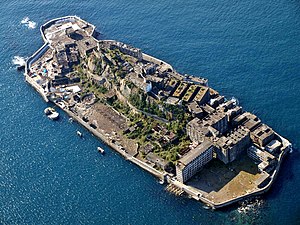Native name: 端島 Nickname: Battleship Island | |
|---|---|
 Aerial view | |
 | |
| Geography | |
| Location | Northeast Asia |
| Area | 0.063 km2 (0.024 sq mi) |
| Area rank | none |
| Administration | |
| Prefecture | |
| City | |
| Demographics | |
| Population | 0 (2020) |
Hashima Island (端島, or simply Hashima, as -shima is a Japanese suffix for 'island'), commonly called Gunkanjima (軍艦島, meaning 'Battleship Island'), is a tiny abandoned island off Nagasaki, lying about 15 kilometres (8 nautical miles) from the centre of the city. It is one of 505 uninhabited islands in Nagasaki Prefecture. The island's most notable features are its abandoned concrete buildings, undisturbed except by nature, and the surrounding seawall. While the island is a symbol of the rapid industrialization of Japan, it is also a reminder of Japanese war crimes as a site of forced labour prior to and during World War II.[1][2]
The 6.3-hectare (16-acre) island was known for its undersea coal mines, established in 1887, which operated during the industrialisation of Japan. The island reached a peak population of 5,259 in 1959. In 1974, with the coal reserves nearing depletion, the mine was closed and all of the residents departed soon after, leaving the island effectively abandoned for the following three decades.
Interest in the island re-emerged in the 2000s on account of its undisturbed historic ruins, and it gradually became a tourist attraction. Certain collapsed exterior walls have since been restored, and travel to Hashima was reopened to tourists on 22 April 2009. Increasing interest in the island resulted in an initiative for its protection as a site of industrial heritage.
After much controversy, the island's coal mine was formally approved as a UNESCO World Heritage Site in July 2015, as part of the Sites of Japan's Meiji Industrial Revolution series. Japan and South Korea negotiated a deal to facilitate this, in which Korea would not object to allowing Hashima Island to be included, while Japan would cover the history of forced labor on the island. To date, disagreements remain as to the extent to which Japan has fulfilled its obligations under this agreement.[3][4][5]
- ^ McCurry, Justin (3 July 2015). "Battleship island – a symbol of Japan's progress or reminder of its dark history?". The Guardian. Retrieved 12 September 2015.
- ^ "Dark history: A visit to Japan's creepiest island". CNN. 13 June 2013. Retrieved 17 September 2015.
- ^ Yanada, Makiko (15 September 2023). "UNESCO Gives Positive Evaluation on Japan's Efforts for Exhibit over Wartime Labor on Gunkanjima". japannews.yomiuri.co.jp. Retrieved 16 May 2024.
- ^ Cite error: The named reference
:8was invoked but never defined (see the help page). - ^ Chung, Esther (18 September 2023). "Korea backs call to provide info on forced labor at Unesco site". Korea JoongAng Daily. Retrieved 16 May 2024.